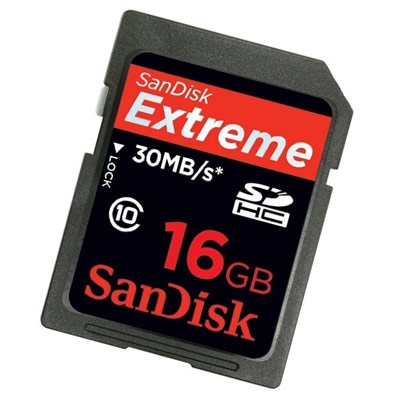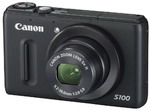Tuesday, August 31, 2010
The Sandisk 16 GB SDHC Extreme SDHC Memory Card: Worth It?
Posted by Jason Dunn in "Digital Home Hardware & Accessories" @ 07:00 AM

The evolution of storage usually goes something like this: the medium gets a lot of attention when it's young, then as it grows older, it typically becomes a commodity that we care less about. Think of the early years of hard drives: moving from 40 MB to 80 MB was a massive improvement, and it was a big day when the first 1 GB drives hit the market. But now? We hardly bother to yawn when a 3 TB drive is announced. Sure, there are some stand-out drives (Western Digital's Raptor line for instance), but for the most part, hard drives are the forgotten technology inside your computer. SSDs, however, are still a young technology: performance improvements, capacity enhancements, and cost drops are still exciting enough to get a geek's heart going.
Flash memory falls somewhere in between those two; from a digital photography perspective, Flash memory storage has become so cavernous that the average person never needs to think twice about running out of space, unless they're shooting 1080p video alongside their still photos. There's still a bit of excitement left in the performance realm though, and SanDisk is at the forefront of pushing faster Flash memory. Their line of Extreme SDHC cards for instance are Class 10 performance, and claim up to 30 MB/s (200x) read and write speeds. They also cost a fair bit more than other brands. I set out to answer a fairly straight-forward question: was it worth it, from a practical standpoint, so shell out the extra money for a SanDisk Extreme SDHC card?
Benchmarks on a computer don't mean much when you're using the Flash memory in a camera, so I decided to do some real world testing between the Sandisk 16 GB Class 10 Extreme SDHC card ($89.18 from Amazon.com) and a Patriot LX 16 GB Class 10 SDHC card ($39.99 from NewEgg). Why the Patriot card? I'd purchased a couple of them, they worked great, and couldn't help but notice that the SanDisk cards were consistently twice as expensive. I hadn't had any trouble with the Patriot cards, but I wanted to know if paying the price premium for the SanDisk card was worth it. After all, Class 10 is simply a measure of the minimum speed that the card will always be able to achieve - it's not the maximum speed of the card, and SanDisk is one of the few companies that puts the MB/s rating of the card on the front of it. Are SanDisk cards faster in the real world?
TEST #1: I took my Nikon D300 DSLR, and using a Delkin SD to CF adaptor, fired a burst of raw photos until the camera stopped shooting (indicating the buffer was full), and used a stopwatch to time how long it took the D300 to finish writing to each card. Over a series of three tests, both the SanDisk and Patriot cards allowed me to snap 14 pictures before the buffer was full, and both cards took 44 seconds to finish clearing the buffer. VERDICT: TIE
TEST #2: I repeated the same test as above, this time with my Panasonic GF-1 camera, and the results over three tests were the same; both the SanDisk and Patriot cards allowed me to snap seven raw photos before stopping, and it took 15 seconds to clear the buffer. VERDICT: TIE
TEST #3: I repeated the same test as above, this time with my Nikon D5000 DSLR. Yes, the pattern continued: the SanDisk and Patriot cards each allowed me to shoot five raw images, and cleared the buffer in 10 seconds. I tried throwing in a Class 6 Patriot card for good measure, and the result didn't change: five photos and 10 seconds. VERDICT: TIE
TEST #4: Since I wasn't seeing any difference at all with the in-camera tests, I switched to desktop tests. I transferred seven raw photos from each card to my desktop PC using a Transcend brand USB card reader, using a stopwatch to time how long it took. Averaged over three tests each, the SanDisk card finished in four seconds, while the Patriot card took five seconds. VERDICT: WINNER SANDISK (BARELY)
TEST #5: To test the write speed, I loaded up each card with 671 files of mixed sizes (1.02 GB total). This would test the write speed of each card. The SanDisk and Patriot cards were only one second apart; the SanDisk card complete the write test in 1 minute 59 seconds, and the Patriot card completed the test in 1 minute 58 seconds. I also tested a Transcend Class 6 16 GB card, and it took 2 minutes 12 seconds. The 4 GB Crucial Class 6 card I tested took over five minutes, at which point I stopped the test because it looked I like it was going to take a very long time. VERDICT: WINNER PATRIOT (BARELY)
As you can tell, the SanDisk Extreme and Patriot LX cards were virtually identical in performance; the one second difference in the read and write tests are within a reasonable margin of error. I'm confident in saying that the SanDisk Extreme SDHC card provides the same level of performance as the Patriot LX card, but you're paying more than twice as much for it.
So is it worth it? From a performance standpoint, no. What I'm not able to test, however, is long-term reliability. There are users who have had certain brands of memory fail, and they'll never buy that brand again. I've owned a variety of memory cards over the years, and I've had both Transcend and Kingston SD cards fail on me; thus far, no SanDisk or Patriot memory has failed - but we know that no brand is perfect and both SanDisk and Patriot will have a small percentage of imperfect Flash memory cards.
It is worth spending your hard-earned money on SanDisk's Extreme line of Class 10 SDHC cards in hopes of better performance? My tests tell me no, it's not. But if using a SanDisk brand card makes you feel like your digital images are better protected from loss, it might be worth it for you. Myself, I'll happily keep using the Patriot LX cards I've purchased.
Jason Dunn owns and operates Thoughts Media Inc., a company dedicated to creating the best in online communities. He enjoys photography, mobile devices, blogging, digital media content creation/editing, and pretty much all technology. He lives in Calgary, Alberta, Canada with his lovely wife, his wonderful son Logan, and his sometimes obedient dog. He's surprised how much he likes the Dell Studio XPS 7100.

Do you enjoy using new hardware, software and accessories, then sharing your experience with others? Then join us on the Thoughts Media Review Team! We're looking for individuals who find it fun to test new gear and give their honest opinions about the experience. It's a volunteer role with some great perks. Interested? Then click here for more information.













